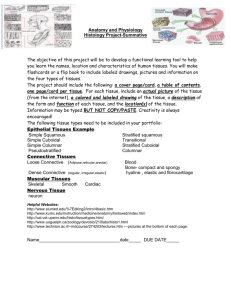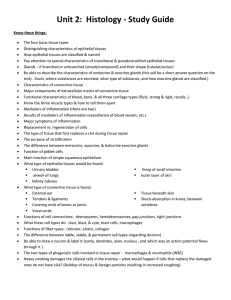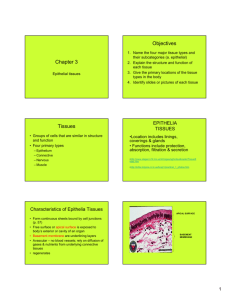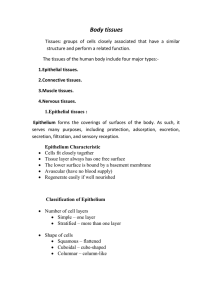REVIEW SHEET FOR EXAM 2 BIOL&241
advertisement
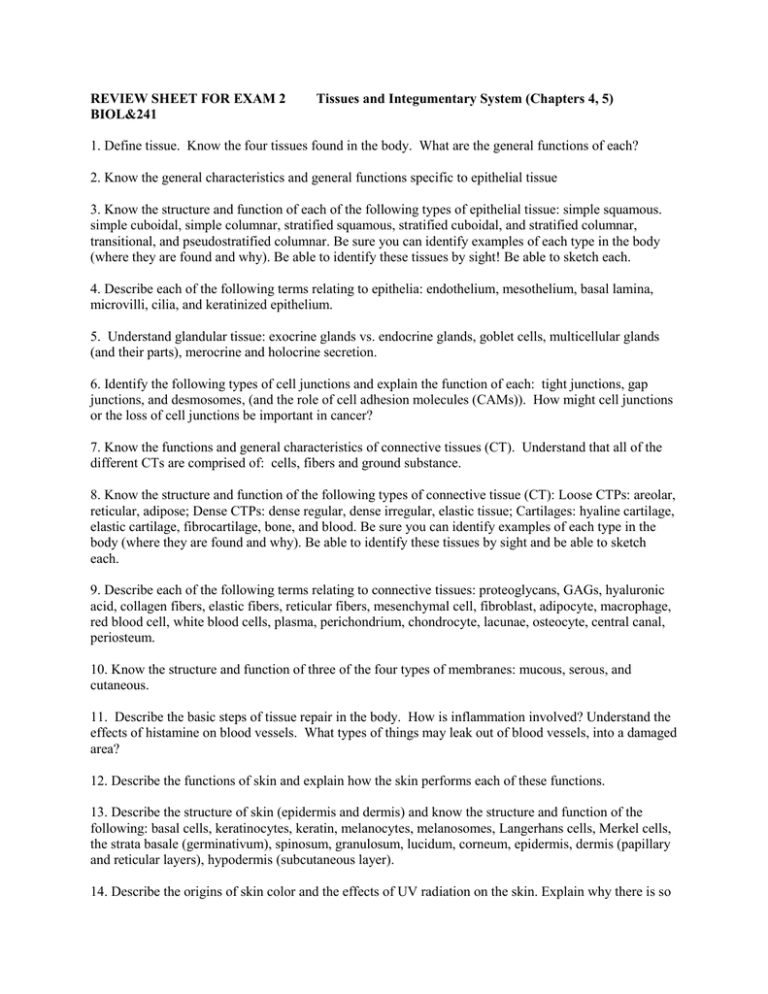
REVIEW SHEET FOR EXAM 2 BIOL&241 Tissues and Integumentary System (Chapters 4, 5) 1. Define tissue. Know the four tissues found in the body. What are the general functions of each? 2. Know the general characteristics and general functions specific to epithelial tissue 3. Know the structure and function of each of the following types of epithelial tissue: simple squamous. simple cuboidal, simple columnar, stratified squamous, stratified cuboidal, and stratified columnar, transitional, and pseudostratified columnar. Be sure you can identify examples of each type in the body (where they are found and why). Be able to identify these tissues by sight! Be able to sketch each. 4. Describe each of the following terms relating to epithelia: endothelium, mesothelium, basal lamina, microvilli, cilia, and keratinized epithelium. 5. Understand glandular tissue: exocrine glands vs. endocrine glands, goblet cells, multicellular glands (and their parts), merocrine and holocrine secretion. 6. Identify the following types of cell junctions and explain the function of each: tight junctions, gap junctions, and desmosomes, (and the role of cell adhesion molecules (CAMs)). How might cell junctions or the loss of cell junctions be important in cancer? 7. Know the functions and general characteristics of connective tissues (CT). Understand that all of the different CTs are comprised of: cells, fibers and ground substance. 8. Know the structure and function of the following types of connective tissue (CT): Loose CTPs: areolar, reticular, adipose; Dense CTPs: dense regular, dense irregular, elastic tissue; Cartilages: hyaline cartilage, elastic cartilage, fibrocartilage, bone, and blood. Be sure you can identify examples of each type in the body (where they are found and why). Be able to identify these tissues by sight and be able to sketch each. 9. Describe each of the following terms relating to connective tissues: proteoglycans, GAGs, hyaluronic acid, collagen fibers, elastic fibers, reticular fibers, mesenchymal cell, fibroblast, adipocyte, macrophage, red blood cell, white blood cells, plasma, perichondrium, chondrocyte, lacunae, osteocyte, central canal, periosteum. 10. Know the structure and function of three of the four types of membranes: mucous, serous, and cutaneous. 11. Describe the basic steps of tissue repair in the body. How is inflammation involved? Understand the effects of histamine on blood vessels. What types of things may leak out of blood vessels, into a damaged area? 12. Describe the functions of skin and explain how the skin performs each of these functions. 13. Describe the structure of skin (epidermis and dermis) and know the structure and function of the following: basal cells, keratinocytes, keratin, melanocytes, melanosomes, Langerhans cells, Merkel cells, the strata basale (germinativum), spinosum, granulosum, lucidum, corneum, epidermis, dermis (papillary and reticular layers), hypodermis (subcutaneous layer). 14. Describe the origins of skin color and the effects of UV radiation on the skin. Explain why there is so much variation in human skin color. Differentiate basal cell carcinoma, squamous cell carcinoma and melanoma. 15. Understand the functions of the accessory structures of the skin: hair, hair follicles, nails, sweat glands (apocrine and merocrine) sebaceous glands and follicles, and ceruminous glands. 16. Understand the specific dangers that burn victims are likely to suffer from. Differentiate between first, second and third degree burns. What is the rule of nines?
